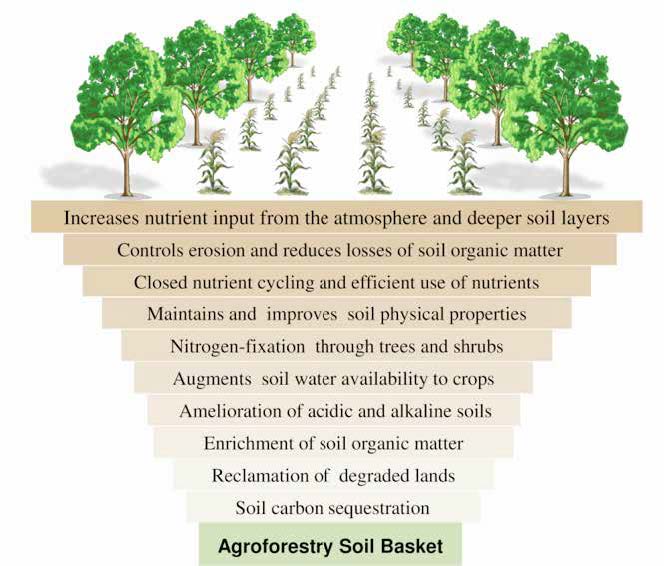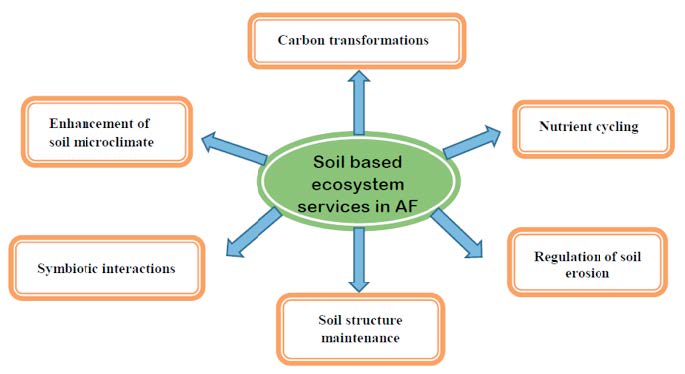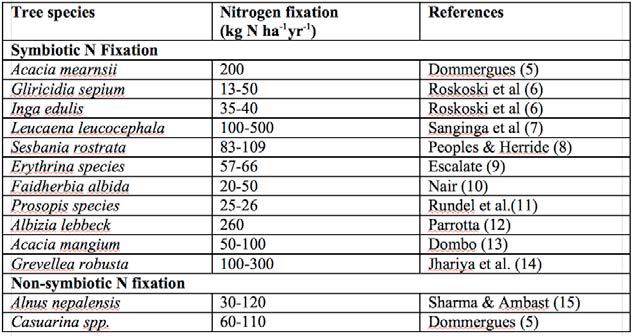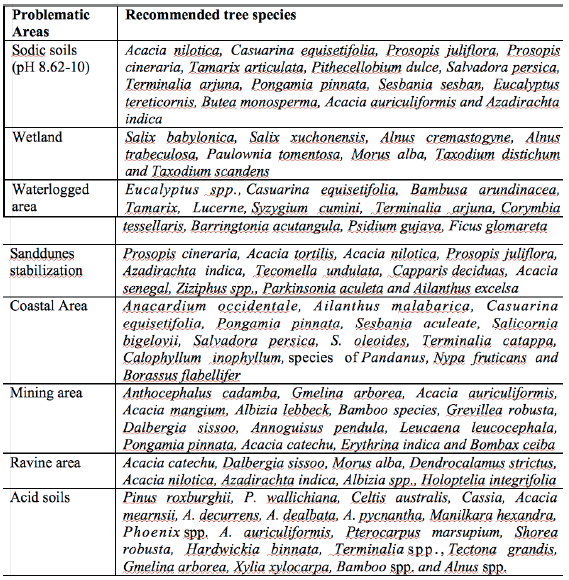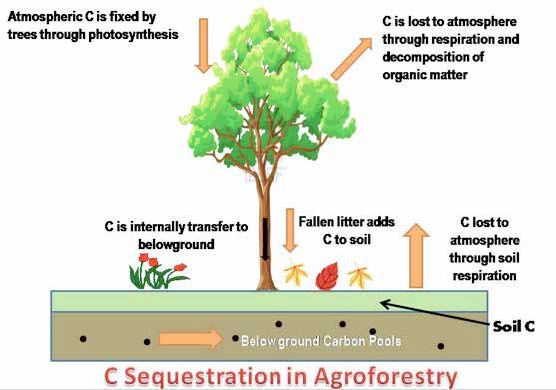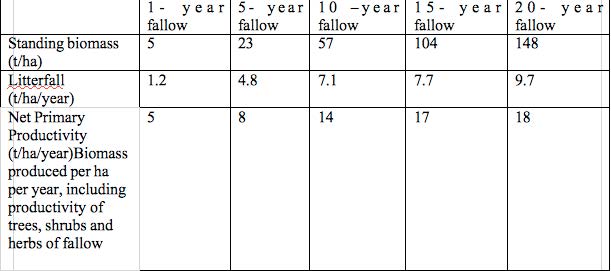Innovative agroforestry for environmental security in India

Introduction
The role of trees in environmental security has been well known for ages.
Trees in agroforestry systems not only provide direct benefits (food, fodder, fuelwood, fertilizers, fibres, etc) but also improve soil fertility, reduce soil erosion, filter atmospheric pollutants and most importantly they maintain carbon balance.
Growing multipurpose trees along with agricultural crops, has been considered as a panacea for maladies of intensive agriculture and deforestation.
It is considered to be one of the key paths towards prosperity of small and marginal farmers facing the challenges of low and uncertain yields, deterioration of the soil and environmental resources and suffering from hunger, malnutrition and poverty particularly in areas that have been bypassed by the green revolution (1).
Agroforestry helps coping with climate change by storing carbon, trees buffers weather-related production losses, enhancing resilience in climate impacts and trees can provide income and a diversity of food sources through tree-based products (2).
Farmers believe agroforestry is a boon particularly during drought when rainfed crops fail and trees provide fodder, fruit, vegetable, fuelwood, timber and fibre for sustaining rural livelihood.
The respected Nobel Prize Laureate, Wangari Maathai at a second World Agroforestry Congress, said: “Trees have an important role to play, not only in climate change mitigation, but also in reducing vulnerability to climate-related risks.”
The potential capacity of Agroforestry to adapt to harsh climatic events is greater than is agriculture because it is playing an important role in ecosystems services, by preventing land degradation, coping with various vagaries of climate. It has been stated that agroforestry systems are treasures of ecosystem services which could act as a symbol of nine planetary boundaries of world.
The multi-functional role of agroforestry (Fig 1) has been emphasized by both the Millennium Ecosystem Assessment and the International Assessment of Agricultural Science and Technology for Development.
Agroforestry for soil based services
Agroforestry practices play an important role in improving the fertility of the soils. Its role in enhancing and maintaining long-term soil productivity and sustainability has been well documented (Fig 2).
Its systems are likely to be more effective in erosion control through supply of litter to the ground surface than through the effects of the tree canopy (3).
It is the source of organic matter by litter fall, debris and nitrogen fixation which can maintain the fertility of soil. Erosion is regarded as one of a number of forms of soil degradation, including the deterioration of physical, chemical and biological properties, all of which require attention.
Agroforestry provides soil based ecosystem services from numerous positive interactions (1).
A major contribution of its trees to soil based ecosystem services occurs as a result of above-ground and below-ground organic inputs that provide food and nutrients needed for the soil organisms involved in carbon transformations and nutrient cycling (Fig 3).
Biological nitrogen fixation (BNF) constitutes a key nutrient input to agro-ecosystems. The contribution of leguminous trees to building up N in degraded soils through BNF is well recognized as an important component of the ecosystem service of nutrient cycling (1). There are significant differences in estimates of BNF in trees, ranging from high rates up to 472 kg N2 ha−1 year−1 in L. leucocephala, Gliricidia sepium, and Calliandra calothyrsus to low rates <50 kg N2 ha−1 yr−1 in Acacia melanoxylon and A. holoserica (4), whereas roots of Casuarina species fix nitrogen at up to 350 kg N ha−1 yr−1.
There are two types of the nitrogen fixation, symbiotic and asymbiotic nitrogen fixation. The symbiotic nitrogen fixed by actinomycttes fungi and nodule forming rhizobium species.
In asymbiotic nitrogen fixation, the free living organisms of soil like clostridium (anaerobic), azotobactor (aerobic), Blue green algae (cynobacteria) and
some lichen fixes of free nitrogen of the soil by all the microorganism living freely or outside the plant cell.
Ecosystem services offered by agroforestry
Trees in agroforestry are offering several services by directs and indirect means.
The followings are the positive interactions (Adapted from Luedeling et al.16 & Atangona et al.17):
- Trees can act as a safety net by capturing nutrients leached from the topsoil, and they can return these to the soil surface as litter (18).
- Trees add litter on soil surface layer and its impact increases the activity of soil biota and reduces exposure of the soil surface. This can improve water infiltration into the soil and reduce surface runoff (19)
- Trees in agroforestry help to reduce evaporative demand of crops per unit of photosynthesis by lowering windspeeds and the higher humidity under trees partially compensates increased water use (20).
- Turnover of fine roots contributes considerable amounts of soil carbon which acts as a major source of soil organic matter in situations where aboveground organic inputs decompose in a surface litter layer (21).
- Nitrogen fixing trees (NFT) can substantially improve the balance and availability of N in agro-ecosystems by adding the nitrogen at the rate of 43-581 kg N ha-1year-1 (Table 1)
- Trees can also trap dust and sediment as well as being sites for nutrient accumulation from animals (including birds) that perch on them or seek shelter in their shade, where they urinate or defecate, is a nitrogenous waste in solid form (22).
- Agroforestry may improve water use efficiency by reducing the unproductive components of the water balance, such as run-off, soil evaporation and drainage (23).
- Trees in agroforestry systems capture water resources mainly from deep soil layers beyond the reach of annual crops. Crop roots in drier surface soil may benefit from hydraulic lift of water by trees from wetter soil at depth (24)
- Microclimate modification by trees also provides ecosystem services, e.g. shade and temperature under tree canopies can be substantially lower than in an open field, potentially reducing heat stress for plants and animals particularly during the hottest hours of the day.
- Reductions in wind speed are directly beneficial to crops, as they reduce the mechanical damage to crops, such as leaf tearing and crop lodging (25).
- Insectivorous birds and beneficial insects hosted by trees have been shown to regulate insect pest populations and pollinate crops (26).
- Multispecies systems can sequester carbon over pure crop stands. Trees and crops (27, 28) may also enhance the soil carbon content, thus participating in climate change mitigation. Rain interception by trees reduces the soil erosion and allows conservation of soil and water.
- The effect of agroforestry on weed suppression is also well documented (9). Mixing tree species may also reduce the specific diversity of the weed stand and lead to a change in biomass distribution between weed species
- Some of the toxic substance secretions i.e. allelopathy may be useful in control of weeds, insect nematodes and disease pathogens (30).
Agroforestry for biodiversity conservation
The concept of agroforestry embraces many intermediate intensity land use forms, where trees still cover a significant proportion of the landscape and influence microclimate, matter and energy cycles and biotic processes (31).
The protection of natural habitats remain the backbone of biodiversity conservation strategies, promoting agroforestry on agricultural land especially in arid and semi arid areas where natural habitat has been highly fragmented.
According to FAO (32), agroforestry improves above ground biodiversity as it provides more habitats and food for birds, small mammals, reptiles, earthworms, insects, etc., which in turn lead to an increase in species diversity and population.
Agroforestry helps in reducing biodiversity loss by providing a protective tree cover along agricultural fields and by providing habitat for a diversity of flora and fauna.
It helps in conserving genetic diversity of ethnocultivars or landraces and for trees that are in danger of loss and require priority conservation (33). Altieri (34) opined that since AFS are more diverse and have low-input strategies, these have greater biological interactions and thus are richer in biodiversity.
Agroforestry can (1) provide secondary habitats for species, (2) reduce the rate of conversion of natural habitats, and (3) create a benign and permeable matrix (corridor) between habitat (5) and conservation of biological diversity by providing other ecosystem services such as erosion control and water recharge,
thereby preventing the degradation and loss of surrounding habitats (31, 35).
Table 2 represents the design and development peculiar to agroforestry systems for biodiversity as well as for commerce.
Agroforestry for problematic soils
Agroforestry has high potential for simultaneously satisfying three important objectives viz., protecting and conserving natural resources; producing a high level of output of economic goods; and improving income and raw materials for rural populations (1).
The studies indicated that under agroforestry systems soil organic carbon and available nutrients increased as compared to growing only trees or a sole agricultural crop.
Experimental evidence under an agri-silvihorticultural system (aonla+ leucaena + blackgram)in rainfed conditions showed that after nine years organic carbon was increased by 65 to 109.4% under closed canopy conditions and by 28.1 to 62.5% under open canopy as compared to initial value (0.32%). The tree are performing prominent role in enhancing soil organic carbon.
The organic carbon per cent under the canopy of aonla is higher than open canopy owing to the fall of aonla leaves, being mostly restricted to the tree canopy (37). An increase in organic carbon, and available N, P and K content in a Khejri (Prosopis cineraria) based silvi-pastoral system compared with no-Khejri soil, indicates retention/plantation of Khejri trees on pasture land. The Khejri based system has led to higher fodder production to meet the needs for food, fodder, fuel and small timber (38, 39).
An increase in soil organic carbon status of surface soil has been observed: 0.39% to 0.52% under Acacia nilotica + Sachharum munja and 0.44% to 0.55% under Acacia nilotica + Eulaliopsis binata after five years. There are indications that Acacia nilotica a tree + Eulaliopsis binata a grass are conservative, more productive and less competitive and are suitable for eco-friendly conservation and rehabilitation of degraded lands of Shivalik foot hills of subtropical northern India (40).
Table 3 shows the soil health status under a Prosopis cineraria-based agroforestry as compared to sole or open field. The studies of an agri-silvicultural system growing of Albizia procera with different pruning regimes, showed that the organic carbon of the soil increased by 13-16% from their initial values which was five to six times higher than growing of either sole tree or a sole crop (41).
Evaluation of soil chemical properties in a traditional agroforestry system of the north-eastern region indicates a spectacular increase in soil pH, organic-C, exchangeable Ca, Mg, K, and build up of avai1able P under different agroforestry practices within 10-15 years (42). Similar results have been shown when MPTs (Multipurpose trees and shrubs) were evaluated in an extremely P-deficient acid Alfisol in Meghalaya.
MPTS, including Alnus nepalensis, Parkia roxburghii, Michelia oblonga, Pinus kesiya, and Gmelina arborea led to: a) greater surface cover (43), b) a constant leaf litter fall and extensive root systems with a 96.2% increase in soil organic carbon, c) a 24.0% increase in aggregate stability, d) an increase of 33.2% in available soil moisture and e) a reduction of 39.5% in soil erosion.
Soils under Acacia auriculiformis, Leucaena leucocephala and Gmelina arborea have a persistently high humification rate while soils under the canopy of Michelia champaca, Tectona grandis and Dalbergia sissoo show low humification of the organic matter (44).
Such improvements in soil quality under agroforestry systems have a direct bearing on long-term sustainability and productivity of soils,being a viable option for eco-restoration, maintenance of soil resources for obtaining ecosystem services, as good air and water quality in the area.
Association of MPTS with arable crops in arable lands and development of agroforestry systems such as agri-silviculture, agri-horticulture, silvi-pasture and horti-pastoral systems on all kinds of degraded wastelands have been examined. The results indicate agroforestry interventions with erosion control structures, such as half moon terraces, contour bunds, grassed waterways, gully plugging and bench terracing are helpful from water conservation and production points of view.
The overall (biomass) productivity, soil fertility improvement, soil conservation, nutrient cycling, microclimate improvement, and carbon sequestration potential of an agroforestry system are generally greater than that of an annual system (45).
Further, alley cropping i.e. intercropping in interspaces of hedgerows, is a proven and sustainable agroforestry technology for resource conservation and sustainable production. Fertiliser Trees are used in agroforestry to improve the soil condition by adding nutrient by nitrogen fixation and leaf shading e.g. Indigofera, Leucaena, Sesbania, and Albizia have been tested as alley or hedgerow crops.
Alley cropping with Leucaena leucocephala was effective for erosion control on land sloping up to 30%. The contour-paired rows of Leucaena hedge, Leucaena and Eucalyptus trees, and 0.75 m wide grass barrier at 1.0 m interval in maize reduced runoff of rainfall from 40% to 30% and soil loss from 21t to 8t ha-1 on 4% sloping land (46).
Multipurpose trees and shrubs (MPTs) can be used on sodic soils where annual crops cannot be grown due to higher pH and EC. Trees, through their roots, open the compact subsoil and improve
water permeability and thus facilitate salt leaching.
By the planting of MPTS, soil pH and EC was decreased to 8.2 and 0.2 mmhos/cm from initial values of 10.5 and 0.736 mmhos/cm, respectively, after 11 years recording. The soil organic carbon, available P and K were increased. Among the tree species tested, Acacia nilotica, Albizia procera, Leucaena leucocephala, Azadirachta indica and Eucalyptus hybrids were found to be the most suitable tree species for rehabilitation of sodic soils and to maintain an eco-friendly systems (47).
Agroforestry has played a major role in the rehabilitation of wastelands, desert and lands degraded by salinisation, water and wind erosion (1). The replacement of field crops and horticulture by silvipasture and agroforestry for, the productive and protective purposes has led to a reduction in runoff in watershed management of 48 to 99% and reduction in soil loss 81 to 98%.
There is the added benefit of a reduction in the rate of population migration from 26.6% before the implementation of Watershed Management to 9.3% during the project period (48). Table 2 exemplifies how different agroforestry tree species suitable for different problem soils can ameliorate the soil condition.
Agroforestry for carbon sequestration
The United Nations Framework Convention on Climate Change (UNFCCC) defines carbon sequestration as the process of removing C from the atmosphere and depositing it in a reservoir (wood or soil).
It entails the transfer of atmospheric CO2, and its secure storage in long-lived pools (49).The carbon cycle in plants is driven by the process of photosynthesis (Fig 4). The agroforestry systems have the potential to sequester large amounts of above and below ground carbon compared to treeless farming systems (50, 51). The agroforestry is well recognised by scientific community for their role in climate change adaptation and mitigation due to its multiple plant species (52).
In India, evidence is now emerging that agroforestry systems are promising land use to increase and conserve aboveground and soil carbon stocks to mitigate climate change (53). Average sequestration potential in agroforestry in India has been estimated to be 25 t C ha-1 over 96 million ha (54).
A study conducted under AICRP-AF shows that in subtropical sub-montane low hill areas agroforestry can enhance carbon sequestration by 50 per cent for both arable and non-arable lands.
A study conducted on the potential of carbon dioxide sequestration of existing green belt at JSW Steel limited in Bellary district of Karnataka found that tree plantations and agroforestry have a huge potential in sequestrating the carbon produced by such heavy industries (55).
Table 3 shows the potential of carbon sequestration by various agroforestry systems in India adapted from Chavan et al. (56).
Shifting agriculture
Biomass
As reported by North Eastern Council, Shillong, Meghalaya, about 1.46 Mha is affected by shifting cultivation in the north-eastern region.
In India, about 2.32 M ha is under shifting cultivation in states other than the north-eastern region and about 2.53 million families are engaged in this practice.
Biomass is the key component of slash and burn agriculture. The biomass stores and conserves the nutrients and recycles them for replenishment of soil fertility. In the areas of slash and burn agriculture, secondary succession rehabilitates the abandoned fields.
The biomass, net primary productivity and litterfall patterns during a 20-year fallow, subsequent to shifting agriculture were studied at Burnihat in north-eastern India (57). Succession was accompanied by increased species diversity, reduced dominance, and increased above-ground productivity which reached 18t ha-1 yr-1 in a 20-year old fallow. Litterfall increased with the age of the fallow up to 10t ha-1 yr-1 in a 20-year fallow (Table 5).
During the agriculture phase a multi-storied crop canopy develops, with perennial crops such as cassava, banana and castor occupying the top layer, cereals constituting the middle layer and cucurbits and legumes forming the lower stratum.
In one of the studies at Burnihat, in north-eastern India (58), the total biomass (root and shoot) obtained from grain and seed yielding crops under a 30-year cycle was 2.5- and 20- times greater than under 10 and 5-year cycles, respectively.
The biomass obtained from leafy and fruit vegetables were maximum under a 5-year cycle, whereas, that from tuberous and rhizomatous crops under the 10-year cycle was almost twice the output of the 5 and 30 year cycles. Maximum economic yield per hectare for rice, maize and Setaria italica (Table 6) was obtained under a 30-year cycle. This yield occurs only once after clearing the fallow of 30 years, meaning that the area of the land would need to be 30 times greater if this cycle was to be operated annually.
In practice, shorter cycles of 5 to 10 years are more common as the population of cultivators has increased in the recent past and available land is scarce.
But the reduction of yield of these crops was 48% and 98% under 10 and 5 years cycles, respectively, c.f. 30 years. The economic yields of leaf and fruit vegetables, however, were much higher in a short cycle of 5-year than in the longer cycles.
Soil carbon
Slash and burn agriculture involves a fallow period from 5 years to sometimes 30 years.
The intensity of burn has significant effects in the properties of soil including organic carbon and pH. Short (slash and burn)cycles of 5 years start with a low budget of carbon as compared to medium and longer cycles (59).
The depletion of soil carbon continues throughout one year of cropping depletes the carbon by up to 22% (Table 7) and further throughout early phases of succession up to 5 years mainly due to a low rate of return of litter (1.2 ton/ha/year) and accelerated oxidation at the surface.
This is a strong reason for a longer cycle. The improvement of soil carbon is maximum for a 10-year fallow due to production of high litterfall (7.1 ton/ha/year), of which bamboo (Dendrocalamus hamiltonii) is the main contributor (53).
This is a good reason for replenishment of soil fertility over a 10-year fallow – the optimum cycle for the yields of cereals and legume compared with a short cycle of 5-year in which the yields of rice and legumes is much reduced.
The change in the soil characteristics with biochar includes an increase in the activity of mycorrhizal fungi and in microbial growth.
Biochar is useful in the acidic tropical soils as it raises pH due to its slightly alkaline nature. If biochar becomes widely available for soil improvement, it will sequester significant amount of carbon that could help counter global warming.
An increase in soil carbon has a significant impact on crop yield.
An increase of one ton of soil carbon would increase crop yield by 20 to 40 kg/ha of wheat, 10 to 20 kg/ha of maize and 1 kg/ha of cowpeas (60).
Every year the farmer is clearing a new piece of land and shifting to fresh land after one year of cropping.
This cycle is still repeated; whereas now that land is scarce there is need to find alternatives of shifting cultivation.
These we have proposed in this paper.
Recommendations to improve and change shifting agriculture
Shifting agriculture with a fallow period of more than 10 years is sustainable ecological, economical and energy efficient and it should continue.
Traditional knowledge of cultivation, resource management and plants used should be documented.
Home gardens which are the sites of high species diversity of native trees, shrubs and herbs should be strengthened.
Degraded lands under shorter cycles should be rehabilitated through cash yielding crops such as fruit, spices and short rotation timbers.
Multi-storied agroforestry systems should be developed integrating cash crops such as areca nuts, coconuts, bananas, citrus, and medicinal and aromatic plants.
Nitrogen fixing trees such as alders (Alnus nepalensis) which coppice excellently and could be managed as a single bole, should find place in high density agroforestry systems.
Bamboo (Dendrocalamus hamiltonii) which is extremely useful and also conserves potassium during the early stage of secondary succession, should be planted in agroforestry systems.
Agroforestry systems could be managed intensively using bio-fertilizers, bio-pesticides and recycling the in-situ produced litter as mulch for nutrient and moisture conservation.
Native stains of useful microbes and fungi should be used for production of bio-fertilizers and bio-fungicides.
The Taungya system should be launched allocating land with plantation crops raised by the Forest Department, as it was extremely successful in the past and still is in several tropical countries.
Fire can be used as a tool to manage the acidic pH of the high rainfall areas.
Involve local people in all research projects and in development of technology. Develop suitable strategies for agricultural marketing and subsidies.
Various agencies should coordinate for the benefit of farmers and should improve their buying capacity.
Ways to overcome hurdles of agroforestry adoption
Complexity: the complex nature of agroforestry systems make it difficult to adopt by farmers. To overcome complexity of agroforestry need to restructure and redesigns the systems as per the need of farmers by considering local species.
Competition: this is the main reason of non-adopting agroforestry systems by farmers. The competition among crop and trees reduces yield due shade and nutrient availability.
To overcome competition there are numerous practices evolved by scientific community through extensive research on “Tree-Crop Interaction” studies.
The proper tree management practices with suitable tree species can helps to reduce the negative impacts of interaction and increases positive benefits.
Mechanization: In the era of intensive agriculture, tree based systems are one of the hurdles for mechanization.
Therefore the adoption laborious agroforestry systems is very slow or negligible. To overcome this problems, the choice of species and spacing is the key challenge for adopting mechanization.
Policy issues: The tree harvesting and transportation is very difficult due to numerous laws, acts and policies of state forest department.
The tree is subject of forest department and there is no tie-up between forest and agriculture department. As per as India is concern, the government is came up with National Agroforestry Policy 2014 to overcome these issues.
Marketing: The commercial agroforestry is flourished only limited states like Punjab, Haryana, Andhra Pradesh and Tamil Nadu. Rest of states don’t have proper marketing channel and wood based industry, which hinders the agroforestry adoption.
Carbon trading and Ecosystem services: As per the UNFCCC and IPCC, agroforestry is considered as remedies for environmental issues like climate change.
The services provided by trees are not yet quantified properly and paid for that. There is no proper and simple mechanism for payment of ecosystem services (PES).
Conclusion
The World’s environmental agendas are now converging to address the economic, social and environmental dimensions of sustainable development through developing agroforestry.
Agroforestry combines traditional knowledge and more recent research evidence related to optimizing the interaction of trees, crops, livestock, water, soil, social systems and economic systems such as markets and value chains in order to respond sustainably to challenges of economic development and biodiversity.
The services rendered by agroforestry are well documented throughout the world.
Livelihood security and environmental security are prominent services of agroforestry in sustainable agricultural development in which the concepts of resilience and sustainability are followed.
Agroforestry must form part of discussions within the global environmental arena.
References
1. Uthappa, A R, Chavan, SB, Dhyani S K, Handa A K & Ram Newaj (2015) Trees for soil health and sustainable agriculture. Indian Farming, 65, 2-5.
2. Ram Newaj, Chavan S & Rajendra Prasad (2013) Agroforestry as a strategy for climate change adaptation and mitigation. Indian Journal of Agroforestry, 15, 41-48.
3. Young, A(1984) Evaluation of agroforestry potential in sloping areas. Working Paper 17. ICRAF, Nairobi, Kenya.
4. Giller, KE (2001) Nitrogen fixation in tropical cropping systems (2nd Edn.) CAB International Publishing,Wallingford.
5. Dommergues, Y R (1987) The role of biological nitrogen fixation in agroforestry. In: Steppler, H.A. and Nair, P.K.R. (eds.), Agroforestry: A Decade of Development, pp. 245-271. ICRAF, Nairobi, Kenya.
6. Roskoski, JP (1982) Nitrogen fixation in a Mexican coffee plantation. In: Robertson, GP, Herrera, R & Roswall, T (eds.), Nitrogen Cycling in Ecosystems of Latin America and the Caribbean, pp 283-292. Martinus Nijhoff, The Hague, The Netherlands.
7. Sanginga, N, Mulongoy, K&Ayanaba, A (1985) Effect of inoculation and mineral nutrients on nodulation and growth of Leucaena leucocephala. In: Ssali, H. and Keya, S.O. (eds.), Biological Nitrogen Fixation in Africa. MIRCEN, Nairobi, Kenya.
8. Peoples, MB & Herridge, DF (1990) Nitrogen fixation by legumes in tropical and subtropical agriculture. Advances in Agronomy, 44, 155-223.
9. Escalante, G, Herrera, R, & Aranguren, J (1984) Fijaci6n de nitrogeno en arboles de dombra (Erythrina poeppigiana) en cacaotales del norte de Venezuela. Pesquisa Agropecuaria Brasileira 19, 223-230.
10. Nair, PKR, Fernandes, ECM & Wambugu, PN (1984) Multipurpose leguminous trees and shrubs for agroforestry. Pesquisa Agropecuaria Brasileira 19, 295-313.
11. Rundel, P W, Nilsen, ET, Sharifi, MR, Virginia, RA, Jarrell, W M, Kohl, DH & Shearer, G B (1982) Seasonal dynamics of nitrogen cycling for a Prosopis Woodland in the Sonoran desert. Plant and Soil, 64, 343-353.
12. Parrotta, J A (1988) Early growth and yield of Albizia lebbeck at a coastal site in Puerto Rico. Nitrogen Fixing Tree Research Reports, 6, 47 – 49.
13. Dombo, DB (2009) A mangium: Amazon Reforestation miracle tree. Plantaver Reforestation, 1-8.
14. Jhariya, M K, Bargali, S S & Abhishek Raj (2015) Possibilities and Perspectives of Agroforestry in Chhattisgarh. In: Precious Forests – Precious Earth, Infotech, 237-259.
15. Sharma, E & Ambasht, R S (1984) Seasonal variation in nitrogen fixation by different ages of root nodules of Alnus nepalensis Plantations, in the Eastern Himalayas. Journal of Applied Ecology, 21, 265-270
16. Luedeling E, Philip JS, Frédéric, B, Jules, B, Neil, IH, van Noordwijk M, Ong, CK, Mulia, R, Lusiana, B, Muthuri, C & Sinclair, FL (2016) Field-scale modeling of tree–crop interactions: Challenges and development needs Agricultural Systems 142, 51–69.
17. Antangana, A, Khasa, D, Chang, S & Degrande A (2014) Tropical agroforestry. Springer Science+Business Media Dordrecht.
18. Rowe, EC, Hairiah, K, Giller, K E, Van Noordwijk, M & Cadisch, G (1998) Testing the safety net role of hedgerow tree roots by 15 N placement at different soil depths. Agroforestry System, 43, 81–93.
19. Hairiah, K, Sulistyani, H, Suprayogo, D, Purnomosidhi, P, Widodo, RH & Van Noordwijk, M (2006) Litter layer residence time in forest and coffee agroforestry systems in Sumberjaya, West Lampung. For Ecol Manag 224 (1), 45–57.
20. Wallace, J & Batchelor, C (1997) Managing water resources for crop production. Philos. Trans. R. Soc., 352, 937–947.
21. Van Noordwijk, M, Rahayu, S, Williams, S E, Hairiah, K, Khasanah, N & Schroth, G, (2004) Crop and tree root-system dynamics. In: Van Noordwijk, M, Cadisch, G, Ong, C (Eds.), Below-ground interactions in Tropical Agroecosystems. Concepts and models with multiple plant components. CABI, Wallingford, U.K., pp. 83–108.
22. Mills, AJ, Milewski, AV, Sirami,C, Rogers, KH, Witkowski, E TF,Stalmans, M & Fey, M V (2012) Aerosol capture by small trees in savannas marginal to treeless grassland in South Africa. Geoderma, 189-190, 124–132.
23. Bayala, J & Wallace, J W (2015) The water balance of mixed tree-crop systems In. In: Black, C, Wilson, J., Ong, C.K (Eds.), Trees-Crop Interactions: Agroforestryin a Changing Climate. CABI, pp. 140–190.
24. Burgess, SSO, Adams, M&A, Turner, NC & Ong, C K (1998) The redistribution of soil water by tree root systems. Oecologia, 115, 306–311.
25. Cleugh, H A, Miller, J M & Böhm, M, (1998) Direct mechanical effects of wind on crops. Agroforestry System, 41, 85–112.
26. Morandin, L, Long, R, Pease, C & Kremen, C (2011) Hedgerows enhance beneficial insects on farms in California’s Central Valley. Calif. Agric., 65, 197–201.
27. Vandermeer, J, Van Noordwijk, M, Anderson, J, Ong, C & Perfecto, I (1998) Global change and multi-species ecosystems: concepts and issues. Agr. Ecosyst. Environ., 67, 1–22.
28. Scopel, E, Findeling, A, Chavez Guerra E & Corbeels, M (2005) Impact of direct sowing mulch-based cropping systems on soil carbon, soil erosion and maize yield. Agron. Sustain. Dev., 25, 425–432.
29. Liebman, M & Altieri, MA (1986) Insect, weed and plant disease management in multiple cropping systems, Editor, MacMillan Publ. Co., N.Y., 383 p
30. Kumar, M J, Lakiang, J & Gopichand, B (2006) Phytotoxic effects of agroforestry tree crops on germination and radicle growth of some food crops of Mizoram. Lyonia, 11, 3-89.
31. Schroth, G, da Fonseca, G A B, Harvey, C A, Gascon, C, Vasconcelos, H L &Izac, A N(2004) Agroforestry and biodiversity conservation in tropical landscapes. Washington, DC: Island Press.
32. FAO (2008) An international Technical Workshop Investing in Sustainable Crop Intensification: The Case for Improving Soil Health. Rome: FAO. http://www.fao.org/ag/ca/doc/ WORKSHOP-LR.pdf (accessed on December 08, 2010).
33. Noble, I R & Dirzo, R(1997) Forests as human-dominated ecosystems. Science, 277, 522–525.
34. Altieri, M A (1995) Agroecology: the science of sustainable agriculture. Boulder, CO: Westview Press.
35. McNeely J A & Schroth, G (2006) Agroforestry and biodiversity conservation–traditional practices, present dynamics and lessons for the future. BiodiversConserv, 15, 549–554
36. Harvey, CA, Schroth, G & Zerbock, O (2007) Designing agroforestry systems to mitigate climate change, conserve biodiversity and sustain rural livelihoods. http://web.catie. ac.cr/cd_multiestrata /Poster/session2/Designing_agroforestry.pdf
37. Ram Newaj, Shukla, S K & Yadav, R S (1999) Varietal evaluation of aonla (Emblica officinalis) in agrisilvihorticultural system under rainfed conditions on marginal lands. Annual Report, NRCAF, Jhansi, pp.44-46.
38. Jaimini, S N, Patel, J M & Patel, S B (2006) Khejri (Prosopis cineraria) based silvipastoral system for dry land areas of North Gujrat. Indian Journal of Forestry, 29, 129-130.
39. Yadav, R S, Yadav, B L, Chhipa, B R, Dhyani, S K & Ram, M (2011) Soil biological properties under different tree based traditional agroforestry systems in a semi-arid region of Rajasthan, India. Agroforestry Systems, 81, 195-202.
40. Samra, J S & Singh, S C (2000) Silvipasture systems for soil, water and nutrient conservation on degraded lands of Shivalik foot hills (subtropical northern India). Indian Journal of Soil Conservation, 28, 35-42.
41. Ram Newaj, Dar, S A & Bhadur, R (2008). Carbon sequestration in agrisilviculture as affected by canopy pruning of Albizia procera under irrigated ecosystem. In: Abstracts National symposium on agroforestry knowledge for sustainability, climate moderation and challenges ahead, 15-17 Dec., 2008, NRCAF, Jhansi (U.P.), India, pp 182.
42. Singh, B P, Dhyani, S K & Prasad, R N (1994) Traditional agroforestry systems and their soil productivity on degraded alfisols/ultisols in hilly terrain. In: Agroforestry systems for Degraded Lands (Eds. P. Singh, P.S. Pathak & M.M. Roy) pp.205-214. Oxford & IBH Pub. Co. Pvt. Ltd., New Delhi.
43. Dhyani, S K, Singh, B P, Chauhan, D S & Prasad, R N (1994)Evaluation of MPTS for agroforestry systems to ameliorate fertility of degraded acid alfisols on sloppy lands. In: Agroforestry systems for Degraded Lands (Eds. P. Singh, P.S. Pathak & M.M. Roy) pp.241-247. Oxford & IBH Pub. Co. Pvt. Ltd., New Delhi.
44. Rao, Subba A & Saha, R (2014). Agroforestry for soil quality maintenance,climate change mitigation and ecosystem services. Indian Farming, 63(11):26-29.
45. Dhyani, S K, Kareemulla K, Ajit & Handa, A K (2009) Agroforestry potential and scope for development across agro-climatic zones in India. Indian J For, 32: 181–190.
46. Narain, P, Singh, G & Joshie, P (1992) Technological needs of vegetative land protection measures. Proc. 7th ISCO Conference, Sydney, Australia, 28-30th September, 1992, 638-643.
47. Khan, S A & Shukla, I N (2003) Suitable MPTS for sodic soils of central plain zone of Uttar Pradesh. Indian J Agroforestry, 5, 119-121.
48. Samra, J S, Vishwanatham, M K & Sharma, A R (1999) Biomass production of trees and grasses in silvipasture system on marginal lands of Doon valley of north-west India 2. Performance of grass species. Agroforestry Systems, 46, 197-212
49. Rizvi, R H, Dhyani, S K, Yadav, R S & Singh, R (2011) Biomass production and carbon storage potential of poplar agroforestry systems in Yamunanagar and Saharanpur districts of north-western India. Current Science, 100, 736-742.
50. Ajit, Dhyani, S K, Ram Newaj, Handa, A K, Prasad, R, Alam, A, Rizvi, R H, Gupta, G, Pandey, K K, Jain, A & Uma (2013) Modeling analysis of potential carbon sequestration under existing agroforestry systems in three districts of Indo-gangetic plains in India. Agroforestry Systems, 87, 1129-1146.
51. Ram Newaj, Dhyani, S K, Chavan, SB, Rizvi, RH, Rajendra Prasad, Ajit, Badre Alam & Handa AK (2014) Methodologies for assessing biomass, carbon stock and carbon sequestration in agroforestry systems. National Research Centre for Agroforestry, Jhansi 45p.
52. Handa, A K, Dhyani, S K & Uma (2015) Three Decades of Agroforestry Research in India: Retrospection for way forward. Agricultural Research Journal PAU, 52, 1-10.
53. Dhyani, S K (2012) Agroforestry interventions in India: Focus on environmental services and livelihood security. Indian J. Agroforestry, 13, 1-9.
54. Sathaye, J A & Ravindranath, NH (1998) Climate change mitigation in the energy and forestry sectors of developing countries. Annu. Rev. Energy Environ, 23, 387-437.
55. Ajit, Dhyani, S K, Handa, A K, Sridhar, K B, Jain, A, Uma, Sasindran P, Kaza, M, Rajendra Prasad & Sriram, K (2014) Carbon sequestration assessment of block plantations at JSW Steel Limited.In Compendium of Abstracts, 3rd World Agroforestry Congress, organized by ICAR, WAC and ISAF at Delhi, Feb. 10-13, 2014, 354-55
56. Chavan S, Ram Newaj, Keerthika A, Asha Ram, Ankur Jha & Anil Kumar (2014) Agroforestry for adaptation and mitigation of climate change. Popular Kheti, 2, 214-220.
57. Toky, O P, Kumar, P & Khosla, P K (1989) Structure and function of traditional agroforestry systems in the western Himalaya. I. Biomass and productivity. Agroforestry Systems, 9, 47-70.
58. Toky, OP, Kumar, R& Khosla, P K (1989) Structure and function of traditional agroforestry systems in the western Himalaya II. Nutrient cycling. Agroforestry Systems, 9, 71-89.
59. Toky, O P& Ramakrishnan, PS (1983). Secondary succession following slash and burn agriculture in north-eastern India.1. Biomass, litter fall and productivity. Journal of Ecology, 71, 735-745.
60. Lal, R (2004) Soil carbon sequestration impacts on global climate change and food security. Science, 304, 1623-1627.
61. Toky, O P& Ramakrishnan, P S (1981) Cropping and yields in agricultural systems of the north-eastern hill region of India. Agro-Ecosystems, 7, 11-25.
62. Ramakrishnan, PS &Toky, OP (1981) Soil nutrient status of hill agro-ecosystems and recovery pattern after slash and burn agriculture (Jhum) in north-eastern India. Plant and Soil, 60, 41-64.
Download pdfFigures

